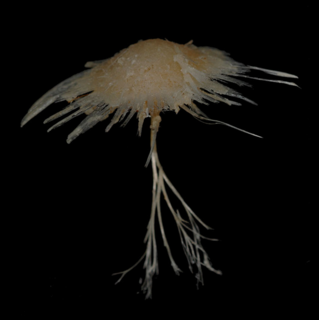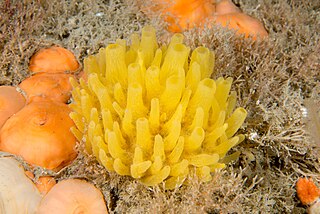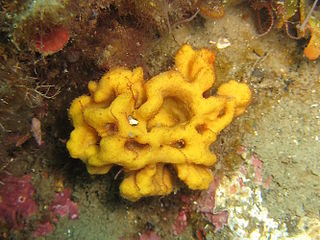
Cladorhiza is a genus of carnivorous sponges, comprising around 40 species found in oceans around the world. Cladorhiza is the type genus of the family Cladorhizidae.

Grantia is a genus of calcareous sponges belonging to the family Grantiidae. Species of the genus Grantia contain spicules and spongin fibers.

Polymastia is a genus of sea sponges containing about 30 species. These are small to large encrusting or dome-shaped sponges with a smooth surface having many teat-shaped projections (papillae). In areas of strong wave action, this genus does not grow the teat structures, but instead grows in a corrugated form.

Chondrocladia is a genus of carnivorous demosponges of the family Cladorhizidae. Neocladia was long considered a junior synonym, but has recently become accepted as a distinct genus.

Halichondria is a genus of sea sponges belonging to the family Halichondriidae. These are massive, amorphous sponges with clearly separated inner and outer skeletons consisting of bundles of spicules arranged in a seemingly random pattern.

Axinella is a genus of sponges in the family Axinellidae first described in 1862 by Eduard Oscar Schmidt. Species of Axinella occur in the Indian and Pacific Oceans. Most of these sponges are smaller than 20 cm, and have a yellow or orange colour.
Stelletta is a genus of sea sponges belonging to the family Ancorinidae.

Haliclona is a genus of demosponges in the family Chalinidae.
Homaxinella balfourensis is a species of sea sponge in the family Suberitidae. It is found in the seas around Antarctica and can grow in two forms, either branching out in one plane like a fan or forming an upright club-like structure.

Myxilla is a genus of demosponge belonging to the family Myxillidae. These sponges usually form encrustations on rock surfaces.

Agelas is a genus of sea sponge in the class Demospongiae.

Callyspongia is a genus of demosponges in the family Callyspongiidae.
Neopetrosia is a genus of marine petrosiid sponges. It was first established by the American spongiologist Max Walker de Laubenfels in 1932. It contains these 27 species:
Cladorhiza inversa is a species of sponge in the taxonomic class Demospongiae. The body of the sponge consists of a spicule and fibers and is water absorbent.

Mycale is a genus of demosponge with 240 recognised species in 11 subgenera. It has been a large genus with multiple subdivisions since it was first described in 1867.
Ciocalypta is a genus of sea sponges belonging to the family Halichondriidae.

Iophon is a genus of sponges belonging to the family Acarnidae. The genus has a cosmopolitan distribution.

Acarnus is a genus of sponges belonging to the family Acarnidae.The genus has almost cosmopolitan distribution.
Tetilla is a genus of demosponges in the family Tetillidae. It is widely distributed. They are mainly found in deeper habitats.












